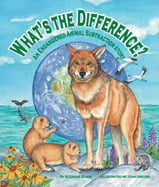Alignment to Standards for KY

| Grade | Number | Standard |
|---|---|---|
| 4 | SC-04-3.4.1a | compare the different structures and functions of plants and animals that contribute to the growth, survival and reproduction of the organisms; |
| 4 | SC-04-4.6.1 | the basic relationships of plants and animals in an ecosystem (food chain). |
| 4 | SC-04-4.6.1a | Plants make their own food. All animals depend on plants. Some animals eat plants for food. Other animals eat animals that eat the plants. |
| 4 | SC-04-4.6.1b | food chains, including the flow of energy, can be used to discover patterns within ecosystems. |
| 4 | SC-04-4.7.2c | All organisms, including humans, cause changes in the environment where they live. Some of these changes are detrimental to the organism or to other organisms; other changes are beneficial |
| 4 | SC-4-ET-S-1 | observe/construct, analyze patterns and explain basic relationships of plants and animals in an ecosystem (e.g., food webs) |
| 4 | SC-4-ET-S-2 | food webs in order to draw conclusions about the relationship between the sunês heat and light and sustaining most life on Earth |
| 4 | SC-4-ET-U-1 | ecosystems are defined by the relationships that occur within them. These relationships can be determined through observation of the organisms and their environment. |
| 4 | SC-4-I-S-2 | how changes in the environment affect the plantsê and animalsê ability to survive |
| 4 | SC-4-I-S-5 | consequences of changes caused by humans or other organisms, and propose solutions to real life situations/dilemmas |
| 4 | SC-4-I-S-6 | support or defend positions on real world environmental problems |
| 4 | SC-4-I-U-3 | people impact their environment in both beneficial and harmful ways. Some of these impacts can be predicted, while others cannot. |
| 4 | SC-4-UD-S-2 | structures and related functions of a variety of plants and animals in order to establish classification schemes |
| 4 | SC-4-UD-U-2 | characteristics of living things can be used to sort them into various groups: the characteristics chosen to establish the grouping depend on the reason for the grouping. |
| 5 | SC-05-4.7.1 | categorize populations of organisms according to the function they serve in an ecosystem (e.g., producers, consumers, decomposers); |
| 5 | SC-5-I-S-3 | cause/effect relationship of altering a particular population of organisms within an ecosystem |
| 5 | SC-5-I-U-1 | Changes to any population may affect the other populations in that ecosystem. |
| 5 | SC-5-I-U-2 | populations interact with each other in an ecosystem form a specific community, but there may be multiple communities within the same ecosystem. |
| 5 | SC-5-I-U-3 | matter and energy flow along multiple paths within a community |
| Primary | SC-EP-4.6.1 | basic relationships of plants and animals in an ecosystem (food chains/interdependance). |
| Primary | SC-EP-4.6.2 | Plants make their own food. All animals depend on plants. Some animals eat plants for food. Other animals eat animals that eat the plants. Basic relationships and connections between organisms in food chains can be used to discover patterns within ecosystems |
| Primary | SC-EP-4.7.1a | When the environment changes some plants and animals survive and reproduce and others die or move to new locations. Examples of environmental changes resulting in either increase or decrease in numbers of a particular organism should be explored in order |
| Primary | SC-P-BC-S-4 | occurrences in the environment that illustrate change (e.g., erosion, earthquakes, weather phenomena, human intrusion) |
| Primary | SC-P-BC-U-2 | understand that living things are found almost everywhere on our planet, but organisms living in one place may be different from those found somewhere else. |
| Primary | SC-P-ET-S-3 | basic relationships of plants and animals in an ecosystem (simple food chains and webs) |
| Primary | SC-P-ET-S-7 | explore a variety of models (e.g., food chains, webs, circuit diagrams) |
| Primary | SC-P-ET-U-2 | all kinds of food that animals eat can be traced back to plants. Food chains/webs are useful models of these relationships. |
| Primary | SC-P-I-S-4 | changes in an environment might affect plantsê and animalsê ability to survive |
| Primary | SC-P-I-S-5 | why some animals are endangered or extinct; why some areas are •protectedê) |
| Primary | SC-P-I-U-2 | when the environment changes, some plants and animals survive and reproduce, and others die or move to new locations. |
| Primary | SC-P-UD-U-3 | some animals are alike in the way they look and in the things they do, and others are very different from one another. |
| Primary | SS-EP-4.4.1 | ways people adapt to/modify the physical environment to meet their basic needs (food, shelter, clothing). |